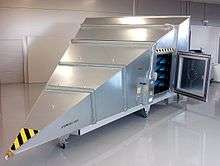GTEM cell

A GTEM or gigahertz transverse electromagnetic cell is a type of electromagnetic compatibility (EMC) test chamber used for radiated EMC testing.[1]
Description
A GTEM cell enclosure is made of conductive material such as metal, in the shape of a long, rectangular pyramid. The pyramid is normally laid flat on one side, although occasionally it may be stood on its base. The base is typically lined internally with radiation-absorbent material (RAM) but the side walls are left bare to act as a waveguide. A stripline conductor, known as the septum, connects internally between the input/output port at the apex and a resistive RF absorber or load at the base. In operation, the equipment under test is placed in the test volume in between the septum and the chassis.
Principles of operation
The GTEM cell forms an enclosed TEM (transverse electromagnetic mode) stripline, which acts as receiving emissions or transmitting emissions antenna:
- When measuring radiated emissions, one end of the stripline is connected to a spectrum analyzer. The other end is terminated with an RF load (e.g., 50Ω).
- When performing radiated immunity, one end of the stripline is connected to a source of radiation (signal generator). The other end is terminated with an RF load.
In operation, emitted radiation (whether from an antenna or from the EUT), travels along the length of the chamber and is absorbed by the absorbent load at the end.
For immunity tests, the field uniformity and the crosspolar coupling of the cell have to be within certain limits set by IEC 61000-4-20.[2]
References
Notes
- ↑ "GTEM". eevblog.com. Retrieved 2011-09-22.
- ↑ "York EMC, GTEM practice guide" (PDF). Retrieved 2013-01-18.
Bibliography
- Nothofer, A, Alexander, M J, Bozec, D, Marvin, A and McCormack, L; Measurement Good Practice Guide No. 65: The use of GTEM cells for EMC measurements, National Physics laboratory, 2003. ISSN 1368-6550.
- Using gtem cells for immunity testing - Evaluation Engineering